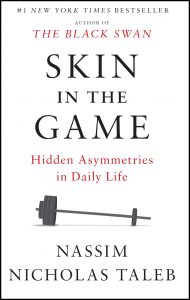
Decision makers need to have risk attached. Most rulers took personal risk.
Decentralisation ensures we have fewer decision makers who are immune to the risks of their decisions. It reduces large structural asymmetries.
Bob Rubin trade – others took his risk and paid for his losses. Government interference in general trend to reduce skin in the game.
Hedge funds are decentralised and owner-operators have more skin in the game.
Interventionists don’t learn as they are not the victims of their mistakes. You can never fully convince someone they are wrong, only reality can.
Systems learn by removing parts. By selecting those less prone to a certain class of mistakes and eliminating others. Experience of the system is different from that of an individual. It is grounded in filtering.
Side effects of specialization. Separating labor from fruits of labour. Maker and user are now separated. Coffee cup ledge in NY north metro.
Taleb traverses the idea of disincentive undesirable behaviour by allowing decisions makers to be more accountable by revealing them to the adverse outcomes of their actions. Examples of these are bankers, bureaucrats, journalists and academicians.
Wall Street bankers and politicians are constantly criticized by leftist academics and journalists for perpetuating inequality, but Taleb’s demand is not for equality, but instead, for symmetry. This can be achieved by holding decision-makers accountable by exposing them to the downsides of their choices and actions.
Doing so will preserve the marketplace and not destroy it with regulations but will instead make sure the rules are the same for everyone. The equality of opportunity approach requires a foundation to build on. In this case, Taleb says is symmetry in terms of incentives or disincentives. Once incentives are aligned with actions and the downside is unavoidable, economic systems will become more strong.
# Key Takeaways:
– Skin In The Game emphasizes the importance of having personal risk and accountability in decision making.
– The book argues that individuals with skin in the game are more likely to make better decisions and have a deeper understanding of the consequences of their actions.
– It also highlights the dangers of decision making by those who do not have skin in the game, such as politicians and bureaucrats.
# Practical Application:
– The concept of skin in the game can be applied in various real-world scenarios, such as business decision making, politics, and personal relationships.
– In business, leaders can ensure that they have skin in the game by investing their own money in the company, rather than relying solely on stock options or bonuses.
– In politics, skin in the game can be achieved by holding politicians accountable for their decisions and actions, rather than allowing them to make decisions without facing any consequences.
– In personal relationships, individuals can ensure that they have skin in the game by taking responsibility for their actions and being accountable for the consequences.
# Valuable Insights for Leaders and Managers:
– Chapter 2, “The Most Intolerant Wins: The Dominance of the Stubborn Minority,” offers valuable insights for leaders and managers on the importance of standing by one’s principles and not giving in to the pressure of the majority.
– Chapter 5, “The Bob Rubin Trade: A Case Study of a Problematic System,” provides valuable insights on the dangers of relying on experts and the importance of having skin in the game in decision making.
– Chapter 7, “The Merchandising of Virtue: The Moral Hazard of Faceless Giving,” offers valuable insights for leaders and managers on the dangers of virtue signaling and the importance of taking personal responsibility for charitable actions.
# Effective Case Studies and Examples:
– The story of Bob Rubin, former Secretary of the Treasury, serves as a powerful case study on the dangers of decision making by those who do not have skin in the game.
– The example of the 2008 financial crisis and the role of banks and financial institutions, who did not have skin in the game, illustrates the consequences of decision making without personal risk.
– The concept of “skin in the game” is effectively illustrated through the analogy of the “Iatrogenics” problem in the medical field, where doctors are not held accountable for their mistakes.
Leave a Reply